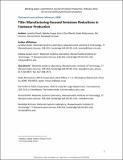| dc.contributor.author | Cheah, Lynette | |
| dc.contributor.author | Matsumura, Seiko | |
| dc.contributor.author | Forterre, Dai | |
| dc.contributor.author | Roth, Richard | |
| dc.contributor.author | Duque Ciceri, Natalia | |
| dc.contributor.author | Olivetti, Elsa A. | |
| dc.contributor.author | Kirchain Jr, Randolph E | |
| dc.date.accessioned | 2016-04-01T14:39:11Z | |
| dc.date.available | 2016-04-01T14:39:11Z | |
| dc.date.issued | 2012-12 | |
| dc.date.submitted | 2012-10 | |
| dc.identifier.issn | 09596526 | |
| dc.identifier.uri | http://hdl.handle.net/1721.1/102070 | |
| dc.description.abstract | What is the burden upon your feet? With sales of running and jogging shoes in the world averaging a nontrivial 25 billion shoes per year, or 34 million per day, the impact of the footwear industry represents a significant portion of the apparel sector's environmental burden. A single shoe can contain 65 discrete parts that require 360 processing steps for assembly. While brand name companies dictate product design and material specifications, the actual manufacturing of footwear is typically contracted to manufacturers based in emerging economies. Using life cycle assessment methodology in accordance with the ISO 14040/14044 standards, this effort quantifies the life cycle greenhouse gas emissions, often referred to as a carbon footprint, of a pair of running shoes. Furthermore, mitigation strategies are proposed focusing on high leverage aspects of the life cycle.
Using this approach, it is estimated that the carbon footprint of a typical pair of running shoes made of synthetic materials is 14 ± 2.7 kg CO[subscript 2]-equivalent. The vast majority of this impact is incurred during the materials processing and manufacturing stages, which make up around 29% and 68% of the total impact, respectively. Other similar studies in the apparel industry have reported carbon footprints of running shoes ranging between 18 and 41 kg CO[subscript 2]-equivalent/pair (PUMA, 2008; Timberland, 2009).
For consumer products not requiring electricity during use, the intensity of emissions in the manufacturing phase is atypical; most commonly, materials make up the biggest percentage of impact. This distinction highlights the importance of identifying mitigation strategies within the manufacturing process, and the need to evaluate the emissions reduction efficacy of each potential strategy. By suggesting a few of the causes of manufacturing dominance in the global warming potential assessment of this product, this study hypothesizes the characteristics of a product that could lead to high manufacturing impact. Some of these characteristics include the source of energy in manufacturing and the form of manufacturing, in other words the complexity of processes used and the area over which these process are performed (particularly when a product involves numerous parts and light materials). Thereby, the work provides an example when relying solely on the bill of materials information for product greenhouse gas emissions assessment may underestimate life cycle burden and ignore potentially high impact mitigation strategies. | en_US |
| dc.language.iso | en_US | |
| dc.publisher | Elsevier | en_US |
| dc.relation.isversionof | http://dx.doi.org/10.1016/j.jclepro.2012.11.037 | en_US |
| dc.rights | Creative Commons Attribution-NonCommercial-NoDerivs License | en_US |
| dc.rights.uri | http://creativecommons.org/licenses/by-nc-nd/4.0/ | en_US |
| dc.source | SSRN | en_US |
| dc.title | Manufacturing-focused emissions reductions in footwear production | en_US |
| dc.type | Article | en_US |
| dc.identifier.citation | Cheah, Lynette, Natalia Duque Ciceri, Elsa Olivetti, Seiko Matsumura, Dai Forterre, Richard Roth, and Randolph Kirchain. “Manufacturing-Focused Emissions Reductions in Footwear Production.” Journal of Cleaner Production 44 (April 2013): 18–29. | en_US |
| dc.contributor.department | Massachusetts Institute of Technology. Materials Processing Center | en_US |
| dc.contributor.department | Massachusetts Institute of Technology. Department of Materials Science and Engineering | en_US |
| dc.contributor.department | Massachusetts Institute of Technology. Materials Systems Laboratory | en_US |
| dc.contributor.mitauthor | Cheah, Lynette | en_US |
| dc.contributor.mitauthor | Duque Ciceri, Natalia | en_US |
| dc.contributor.mitauthor | Olivetti, Elsa A. | en_US |
| dc.contributor.mitauthor | Roth, Richard | en_US |
| dc.contributor.mitauthor | Kirchain, Randolph | en_US |
| dc.relation.journal | Journal of Cleaner Production | en_US |
| dc.eprint.version | Author's final manuscript | en_US |
| dc.type.uri | http://purl.org/eprint/type/JournalArticle | en_US |
| eprint.status | http://purl.org/eprint/status/PeerReviewed | en_US |
| dspace.orderedauthors | Cheah, Lynette; Ciceri, Natalia Duque; Olivetti, Elsa; Matsumura, Seiko; Forterre, Dai; Roth, Richard; Kirchain, Randolph | en_US |
| dc.identifier.orcid | https://orcid.org/0000-0002-8043-2385 | |
| mit.license | PUBLISHER_CC | en_US |
| mit.metadata.status | Complete | |
